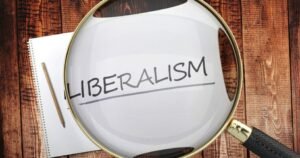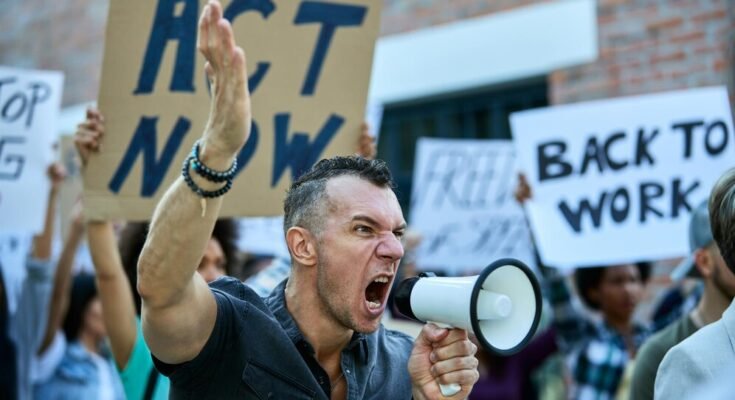Liberalism is a political idea that focuses on keeping individuals free and making sure their freedom is at the center of politics. Liberals believe that government is needed to protect people from harm. It can also become a threat to liberty. Thomas Paine, a pamphleteer during the American Revolution, called the government a necessary evil. Laws, judges, and police are necessary to protect individuals, but they can also be misused.
The challenge is to create a system that gives the government the power to safeguard individual liberty without letting those in power misuse that authority. But classical liberalism and modern neoclassical liberals believe that this is the only role the government should have. However, since the late 19th century, most liberals think that government powers can both protect and promote individual freedom.
The main job of the government is not only to protect but also to remove obstacles that prevent people from living freely or reaching their full potential. These obstacles include poverty, disease, discrimination, and ignorance. There are differences among liberals on whether the government should only protect or also promote individual freedom. These are seen in the varying ideas of liberalism in the United States and Europe.
In the United States, liberalism is linked to the welfare state policies of the New Deal under President Franklin D. Roosevelt. It is more commonly associated with a commitment to limited government. And laissez-faire economic policies in Europe.
In this article, we will discuss the political foundations and history of liberalism from the 17th century to the present, with a focus on the different prevailing ideas in the United States and Europe since the late 20th century. So, just keep reading and get to know about liberalism.
Idea Of Liberalism.
The idea of liberalism in politics has its beginnings in the Enlightenment. A time that began in the late 17th century and ended in the early 19th century. The Enlightenment was a major period in shaping the modern world. This gave rise to various ideologies like capitalism, liberalism, fascism, and communism.
Thomas Hobbes, a political theorist, presented a new perspective on civilization. He suggested a concept called the state of nature. Which could separate political authority from the influence of God. This marked an important development in political thought during the Enlightenment.
Foundations in Politics.
Even though liberal ideas were not visible in European politics until the early 16th century,. Liberalism has a pretty long history that goes back to the Middle Ages and even earlier. Back then, people’s rights and duties were determined by where they stood in a social hierarchy that valued obedience and conformity a lot. Europe gradually became more commercialized and urbanized during the later Middle Ages. With the intellectual revival of the Renaissance and the spread of Protestantism in the 16th century, the old social hierarchy started to break down. This led to a fear of instability, and many believed that absolute monarchy was the only solution to avoid civil unrest.
By the end of the 16th century, the power of the papacy had weakened in most of northern Europe. Rulers tried to unify their realms by making everyone follow either Roman Catholicism or the ruler’s preferred version of Protestantism. This push for conformity resulted in the Thirty Years War (1618–48), causing a lot of damage to Europe. When attempts to eliminate opposing beliefs failed, some countries started accepting tolerance as a better option. In places where one belief system triumphed, it became clear that being too strict about what people believed. It was not good for prosperity and order.
The goals of national rulers and the need for growing industry and commerce eventually led to the adoption of economic policies based on mercantilism. This school of thought suggested that the government should intervene in the country’s economy to increase state wealth and power. However, as this intervention started favoring established interests and hindering entrepreneurship, members of the emerging middle class began to challenge it.

This challenge played a significant role in the major revolutions in England and France in the 17th and 18th centuries. Such as the English Civil Wars (1642–51), the Glorious Revolution (1688), the American Revolution (1775–83), and the French Revolution (1789). Classical liberalism, as a clear set of ideas, emerged from these revolutions.
In the English Civil Wars, King Charles I, who wanted absolute power, was defeated by Parliament and eventually executed. The Glorious Revolution led to the removal of James II and the establishment of a balanced government. Where power was divided between the monarch, ministers, and Parliament. This system later became a model for liberal political movements in other countries.
The political ideas that inspired these revolts found formal expression in the works of the English philosophers Thomas Hobbes and John Locke. Hobbes argued in Leviathan (1651) that the absolute power of the sovereign was justified by the consent of the governed. It is given in a hypothetical social contract for peace and security. Locke, in Two Treatises of Government (1690), also had a social contract theory. But they believed that people could not reasonably give absolute power to a ruler. He argued that political authority’s purpose is to protect individuals, persons, and property. And guarantee their natural rights to freedom of thought, speech, and worship. Locke thought a revolution was justified when the sovereign failed to fulfill these obligations, and he may have written his major work to justify the revolution two years before its publication.
By the time Locke published his Treatises, English politics had become a competition between two loosely connected parties, the Whigs and the Tories. These parties are the ancestors of today’s Liberal Party and Conservative Party in Britain, respectively. Locke was associated with the Whigs, and liberalism is often seen as deriving from the attitudes of these Whig aristocrats. Who were connected to commercial interests and were suspicious of monarchy power. The Whigs dominated English politics from the death of Queen Anne in 1714 to the accession of King George III in 1760.
Characteristics in General.
Liberalism has its roots in two main aspects of Western culture. First, the West has always valued individuality more than other societies, which often focus on status, caste, and tradition. Throughout history, people were usually seen as part of a larger group. Like a clan or tribe, with individuals playing subordinate roles.
Liberalism developed in the West as a result of changes that emphasized the importance of human individuality. Liberalism is about setting individuals free. It’s closely linked to the idea of individualism.
Another influence on liberalism comes from the way Europeans handle conflicts in politics and economics. They engage in adversarial processes. Where institutionalized competition, like political parties competing in elections or different producers in a market, creates a dynamic social order, the idea of adversarial systems is not always accepted.
Traditionally, many believed in a more cooperative view of the state, resembling an organic structure. Where social classes work together with distinct yet complementary roles, the acceptance of competition as essential for good government was not widespread in Europe until the 19th century.
The Principles of Liberalism and Democracy.
Early liberals wanted to free people from two social controls—religious conformity and aristocratic privilege—imposed by the government. Someone aimed to limit government power over individuals while making it accountable to the people. They believed in a government based on majority rule. Where the government follows the will of the majority. They achieved this through periodic elections. However, they struggled with deciding who should have the right to vote. Some liberals were torn between supporting broad voting rights and fearing it might harm private property.
Many 18th- and 19th-century liberal politicians were wary of giving too much power to the people. As a result, they restricted voting rights to property owners. Even in the 1867 Reform Bill in Britain, property qualifications for voting were not eliminated. In France, despite the idea of universal male suffrage, only a small fraction of the population could vote. The United States granted universal male suffrage to whites in 1860. However, racial and sexual biases continued to limit voting rights. Women’s suffrage faced challenges and was achieved in many places only in the early 20th century.
Despite concerns from the wealthy, voting rights expanded in Europe during the 19th century, driven by a liberal belief in equality. However, liberals struggled to balance majority rule with limiting its power. They grappled with how to check the majority’s power without creating a new elite, especially after hereditary elites were discredited.
The separation of Powers Refers to the Division of Governmental Authority into Distinct Branches.
The liberal way of dealing with the issue of restricting the authority of a democratic majority involves using different methods. Firstly, they separated powers among various government branches like the legislature, executive, and judiciary. This setup, along with a system of checks and balances, was established in the United States Constitution and explained in the Federalist Papers (1787–88) by Alexander Hamilton, James Madison, and John Jay.
Rights.
The third part of the solution comes from the idea of liberalism, which is all about valuing the freedom and dignity of each person. The goal is to limit power to protect this freedom. Liberals believe individuals are not just citizens following rules together. They are people with rights that the government can not violate if we want democracy to work. For a majority decision to happen, individuals must be free to share their opinions. This includes the right to speak and write openly. freedom to associate and organize, and, most importantly, freedom to express opinions without fear of punishment.
People also have rights beyond being citizens. These rights include personal safety and protecting individuals from being unfairly arrested or punished. Some rights keep certain aspects of life private in a liberal democracy. Some matters do not concern the government, like practicing religion, creating art, or parents raising their children. In the 18th and 19th centuries, liberals considered rights in areas like production and trade important too.

Important declarations of such rights can be found in historical documents. Like the British Bill of Rights (1689), the U.S. Declaration of Independence (1776), and the Constitution (ratified 1788). The French Declaration of the Rights of Man and the Citizen (1789) and similar documents worldwide. These declarations emphasized that freedom is not just about voting occasionally, it’s the essential right for people to live their own lives.
Liberalism and Utilitarianism Represent Distinct Philosophical Perspectives.
In the late 1700s and early 1800s, thinkers like Bentham, philosopher James Mill, and Mill’s son, John Stuart Mill, used basic economic ideas in politics. people believed in utilitarianism, the idea that something is valuable if it’s useful or makes people happy. They argued that all laws should aim for the greatest happiness for the greatest number.
They thought a good government should be like a representative democracy, where people choose their leaders. This, they believed, was the best way for the government to work for the people. Similar to how a market economy functions, they wanted a political system that gave citizens the most freedom to make choices. As long as it did not disrupt efficient government and social harmony.
The utilitarians supported ideas like better education, more people having the right to vote, and regular elections to make sure the government is responsible to the people. They did not believe in natural rights, they strongly defended individual freedoms. Such as freedom of religion, speech, press, and assembly. These ideas are at the core of modern democracy. John Stuart Mill’s work “On Liberty” in 1859 further emphasized these liberties, arguing that the government should only regulate individual behavior when it harms others.
Economic Foundations Simplified.
Liberal ideas about politics and economics originated in Great Britain. In the 18th century, the British monarchy faced challenges due to parliamentary limitations. Other rulers focused on military dominance, linking it to a robust economic base. The prevailing mercantilist theory treated international trade as a win-lose game. It leads governments to intervene in pricing. It protects industries and controls economic information.
The physiocrats in France challenged this approach, advocating for unrestricted economic competition. With the motto “laissez faire, laissez passer, Adam Smith’s “The Wealth of Nations” further emphasized the benefits of free trade. It suggests that competition results in more and better goods at lower prices. In a genuinely free market, individuals pursuing self-interest contribute to the public good. Other systems, like state control or monopolies, were seen as causing regimentation, exploitation, and economic stagnation.
Economic systems not only decide what goods are produced but also how they are distributed. In a market economy, the price mechanism is determined by individual buyer’s and seller’s resources. The system aims to match demand and supply. And rewarding individuals in proportion to their merit. Classical liberal economists advocated abolishing feudal and mercantilist restrictions. As well as ending tariffs on imports, and trusting in the self-regulating market. Their ideas gained traction during Britain’s Industrial Revolution, as the country became prosperous through free trade.
Classical liberals insisted on limiting government power in both economic and political matters. Jeremy Bentham succinctly advised the state to be quiet, and many believed that less government interference led to better outcomes.
In 19th Century.
In the 1800s, liberalism was a big deal in Europe. It was like a popular idea and way of doing things. But how well it worked depended on different things in each country, like how strong the ruler was, and how fancy the rich people were. And how fast things were changing with industries, and how the country was coming together.
Even the religion of the place could change how liberals acted. In places where people followed the Roman Catholic faith, like France, Italy, and Spain. Liberalism went a bit against the church. Liberals there liked making laws that limited the power of the Catholic leaders.
In the olden days in Great Britain, the Whigs turned into the Liberal Party around the mid-1800s. They were big on making positive changes, and other liberal parties in Europe followed their example. The Liberals were the driving force behind ending Britain’s slave trade in 1807 and slavery in all British territories in 1833. They also worked on giving more people the right to vote. Which resulted in the Reform Bills of 1832, 1867, and 1884–85. The Liberal Party, led by William Gladstone from 1868 to 1894, made significant reforms and reached the peak of British liberalism.

In Europe, liberal ideas did not always have the same widespread support and strong political backing as they did in Britain. In France, liberal goals were pursued during the Revolutionary and Napoleonic periods. After the Bourbon Restoration in 1815, French liberals faced a long struggle to establish constitutional liberties. And also involve more people in government. This was fully achieved when the Third Republic was formed in 1871.
Liberalism was also driven by a desire for independent and constitutional nations in Europe and the Americas. Influential figures like the Founding Fathers in the United States, Simón Bolívar in South America, leaders of the Risorgimento in Italy, and Lajos Kossuth in Hungary aimed for unified, free states with their parliaments and laws. However, the Revolutions of 1848 showed that liberalism faced challenges, especially in Germany, where militarized Prussia and Austria played significant roles. Italy’s unification was also delayed until the 1860s due to Austria, Napoleon III of France, and opposition from the Vatican.
Foundations of Nativist Ideology.
Some people strongly oppose immigration. They worry that it might harm their nation’s culture, religion, or identity and affect job opportunities for local citizens. These individuals are known as nativists. Often, we blame immigrants for issues like crime, unemployment, and a strain on public services.
Nativists claim that immigrants take jobs away from local people, leading to fewer opportunities and lower wages. They argue that immigrants do not pay enough taxes to cover the services they use. And rely too much on social welfare programs. Most economists believe that immigration is generally positive for a country’s economy.
Nativists also criticize immigrants for supposedly isolating themselves in their communities and not learning the local language. Which they believe creates cultural divisions. In some predominantly white societies, like France and the United States. Nativists have adopted a far-right conspiracy theory called replacement theory.
This theory suggests that elites, possibly directed by Jewish individuals, are intentionally replacing white citizens. With non-white immigrants. They argue that non-white populations pose a threat to white identity and use this theory to support efforts to limit immigration. And promote what they see as racial purity among whites.
The Consequences of Nativism in the United States.
The United States sees itself as a country built by immigrants, and the established white communities have consistently shown unfriendliness towards immigrants from nonwhite nations. An example is the California Gold Rush in 1849, which increased Chinese immigration to the western United States.
Chinese laborers were hired for the construction of a transcontinental railroad starting in 1862. However, extensive immigration and anti-Chinese sentiments among white workers were fueled by politicians. This led to the Chinese Exclusion Act of 1882, banning Chinese immigration for ten years. This law promoted the idea of the yellow peril, a perceived threat from East Asian peoples to Western societies.
The discriminatory language of the act marked a turning point in subsequent American immigration policies, favoring Europeans. From the northern and western regions. The law influenced similar legislation in Australia, Canada, and other English-speaking countries. The Chinese Exclusion Act was repealed in 1943 with the Magnuson Act, allowing a yearly quota of 105 Chinese immigrants.

In World War II, the nativist ideology reached a peak. President Franklin D. Roosevelt signed Executive Order 9066 after Japan attacked Pearl Harbor. This order forced around 120,000 Japanese Americans from the West Coast to internment camps in the western U.S. It was for national security. Despite evidence that Japanese Americans were not spies, the U.S. Supreme Court upheld their forced relocation in the Korematsu v. United States case in 1944. In 1988, the Civil Liberties Act compensated over 80,000 Japanese Americans with $20,000 each. And Congress formally apologized for the government’s policy.
After the September 11 attacks in 2001, nativist discourse resurfaced, with some advocating for the internment of Muslims similar to the World War II Japanese American internment. These calls faced opposition from civil rights groups, politicians, and the public. It was not until the 2016 election and Donald Trump’s victory that nativist discourse influenced federal immigration policies.
Trump, promising to ban Muslim immigration during his campaign, issued an executive order. In 2017, immigration came from seven Muslim-majority countries. The U.S. Supreme Court later upheld a modified version of the ban, explicitly repudiating the Korematsu v. United States decision in 2018, considering it gravely wrong and overturned in the court of history.
FAQs.
-
What is a liberal subject?
A liberal education combines an education in the classics, literature, the humanities, moral virtues, and others. The term liberal education in the modern sense should not be confused with liberal arts education, the latter deals with academic subjects, while the former deals with ideological subjects.
-
What is an example of a liberal?
The fundamental liberal ideals of freedom of speech, freedom of the press, freedom of religion, the separation of church and state, the right to due process, and equality before the law are widely accepted as a common foundation of liberalism.
-
Why is it called liberal studies?
Liberal arts derive from the classical and medieval collection of subjects known as art liberalism. the knowledge worthy of a free person. The idea is that freedom only exists when you can recognize alternatives.
-
What is the definition of libertarianism?
Libertarians seek to maximize autonomy and political freedom, emphasizing equality before the law and civil rights to freedom of association, freedom of speech, freedom of thought, and freedom of choice.



